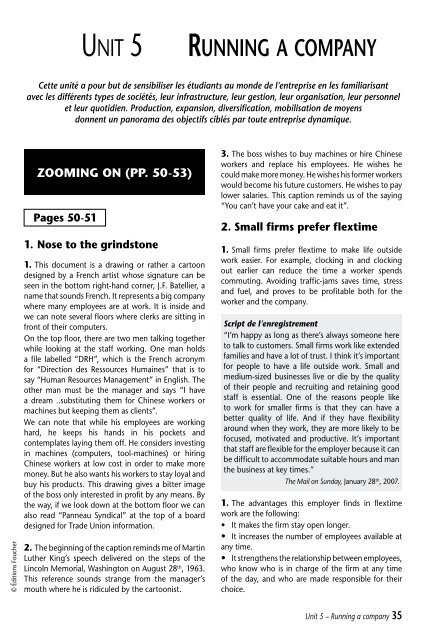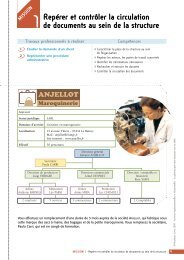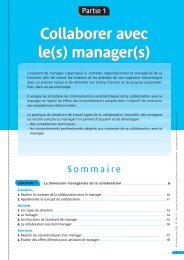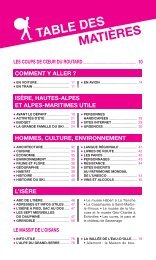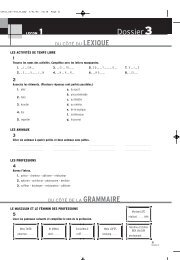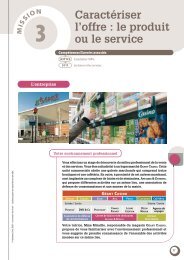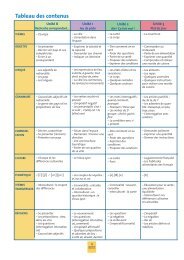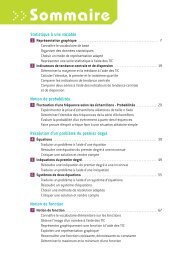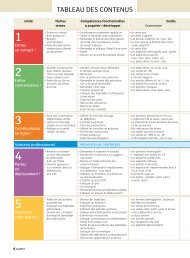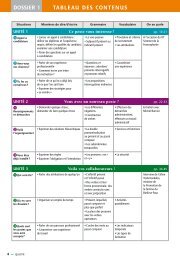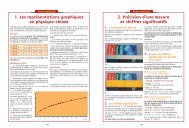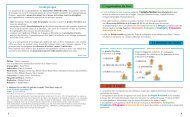GUIDE PÉDAGOGIQUE - Hachette
GUIDE PÉDAGOGIQUE - Hachette
GUIDE PÉDAGOGIQUE - Hachette
You also want an ePaper? Increase the reach of your titles
YUMPU automatically turns print PDFs into web optimized ePapers that Google loves.
© Éditions Foucher<br />
Zooming on (pp. 50-53)<br />
pages 50-51<br />
Un i t 5 ru n n i n G a co m Pa n y<br />
Cette unité a pour but de sensibiliser les étudiants au monde de l’entreprise en les familiarisant<br />
avec les différents types de sociétés, leur infrastructure, leur gestion, leur organisation, leur personnel<br />
et leur quotidien. Production, expansion, diversification, mobilisation de moyens<br />
donnent un panorama des objectifs ciblés par toute entreprise dynamique.<br />
1. nose to the grindstone<br />
1. This document is a drawing or rather a cartoon<br />
designed by a French artist whose signature can be<br />
seen in the bottom right-hand corner, J.F. Batellier, a<br />
name that sounds French. It represents a big company<br />
where many employees are at work. It is inside and<br />
we can note several floors where clerks are sitting in<br />
front of their computers.<br />
On the top floor, there are two men talking together<br />
while looking at the staff working. One man holds<br />
a file labelled “DRH”, which is the French acronym<br />
for “Direction des Ressources Humaines” that is to<br />
say “Human Resources Management” in English. The<br />
other man must be the manager and says “I have<br />
a dream ..substituting them for Chinese workers or<br />
machines but keeping them as clients”.<br />
We can note that while his employees are working<br />
hard, he keeps his hands in his pockets and<br />
contemplates laying them off. He considers investing<br />
in machines (computers, tool-machines) or hiring<br />
Chinese workers at low cost in order to make more<br />
money. But he also wants his workers to stay loyal and<br />
buy his products. This drawing gives a bitter image<br />
of the boss only interested in profit by any means. By<br />
the way, if we look down at the bottom floor we can<br />
also read “Panneau Syndical” at the top of a board<br />
designed for Trade Union information.<br />
2. The beginning of the caption reminds me of Martin<br />
Luther King’s speech delivered on the steps of the<br />
Lincoln Memorial, Washington on August 28 th , 1963.<br />
This reference sounds strange from the manager’s<br />
mouth where he is ridiculed by the cartoonist.<br />
3. The boss wishes to buy machines or hire Chinese<br />
workers and replace his employees. He wishes he<br />
could make more money. He wishes his former workers<br />
would become his future customers. He wishes to pay<br />
lower salaries. This caption reminds us of the saying<br />
“You can’t have your cake and eat it”.<br />
2. Small firms prefer flextime<br />
1. Small firms prefer flextime to make life outside<br />
work easier. For example, clocking in and clocking<br />
out earlier can reduce the time a worker spends<br />
commuting. Avoiding traffic-jams saves time, stress<br />
and fuel, and proves to be profitable both for the<br />
worker and the company.<br />
Script de l’enregistrement<br />
“I’m happy as long as there’s always someone here<br />
to talk to customers. Small firms work like extended<br />
families and have a lot of trust. I think it’s important<br />
for people to have a life outside work. Small and<br />
medium-sized businesses live or die by the quality<br />
of their people and recruiting and retaining good<br />
staff is essential. One of the reasons people like<br />
to work for smaller firms is that they can have a<br />
better quality of life. And if they have flexibility<br />
around when they work, they are more likely to be<br />
focused, motivated and productive. It’s important<br />
that staff are flexible for the employer because it can<br />
be difficult to accommodate suitable hours and man<br />
the business at key times.”<br />
The Mail on Sunday, January 28th , 2007.<br />
1. The advantages this employer finds in flextime<br />
work are the following:<br />
• It makes the firm stay open longer.<br />
• It increases the number of employees available at<br />
any time.<br />
• It strengthens the relationship between employees,<br />
who know who is in charge of the firm at any time<br />
of the day, and who are made responsible for their<br />
choice.<br />
Unit 5 – Running a company 35


